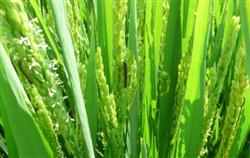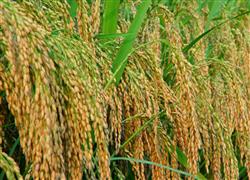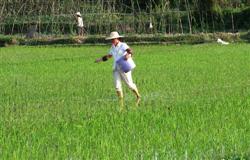What if the rice glume is opened and not filled?

What if the rice glume is opened and not filled? If there is any way to solve the problem, the phenomenon of glume opening and non-grain filling after heading occurs in many places, mainly in hybrid indica rice and basically not in japonica rice. Because this phenomenon occurs in different years, both with and without drugs, it has nothing to do with climate and pesticide damage. In recent years, this phenomenon in rice is mostly limited to some areas, mainly hybrid rice, the fields that have occurred will usually occur year after year. He believes that the phenomenon of glume opening and non-grain filling in rice is mainly related to soil factors, but whether it is lack of some nutrient elements or arsenic poisoning is still unknown and needs further study. He suggested that fields with rice glumes open and no grain filling had better be planted with japonica rice next year. Arsenic poisoning may cause rice glume opening and non-filling, arsenic poisoning may cause rice to appear double glume (double glume) after flowering, the glume is deformed, it is not closed, it is bent like a beak, and there is little fruit in the glume, even if it is fruiting, there is only a short green grain rice, immature. The plots of "changing drought into water" occur more frequently. The main cause of rice glume deformity, heavy glume and non-fruiting is that after long-term dry cultivation, arsenic in the soil is enriched to the surface soil, especially when high-yield vegetables are planted for a long time, resulting in relative deficiency of sulfur and imbalance of sulfur and arsenic, resulting in arsenic poisoning in rice. In the fields where cucumber, cowpea and leek were planted in the past, sulfur was consumed more and arsenic was enriched, and poisoning was more likely to occur after replanting rice. There is a gully system around the field, with more sulfur and relatively less arsenic, and less poisoning in rice. Measures to prevent arsenic poisoning: first, increase the application of organic fertilizer, increase the content of soil organic matter, reduce the activity of toxic substances, and improve the detoxification ability of rice. The second is to increase the application of sulfur-containing fertilizers. In the field of "changing drought into water", attention should be paid to reducing the amount of nitrogen fertilizer and phosphorus fertilizer when applying base fertilizer, and potassium sulfate should be selected for potash fertilizer. The third is to adjust the method of water slurry management. The topography of the "drought to water" field is often high, and it is easy to be short of water and drought in the early stage, so the water layer should be established earlier (before the young panicle differentiation stage) to reduce the concentration of arsenic in the soil and release it in advance, so as to avoid the sudden establishment of water layer at the booting stage. because at this time, rice is extremely sensitive to arsenide and is prone to poisoning and fruiting. The fourth is to change the farming system. Growing rice in dry land is easy to be threatened by drought, and it is easy to cause zinc deficiency, manganese poisoning, boron poisoning and arsenic poisoning. Perennial arsenic poisoning in the fields should be changed to vegetables, corn, sweet potato and other autumn crops, not rice, to seek advantages and avoid disadvantages. Other reasons also lead to rice glume opening and non-filling, such as rice encountered adverse environmental conditions during panicle differentiation and development, such as abnormal high temperature, abnormal low temperature, rain and waterlogging, or stimulated by some drugs, there will be glume deformity, poor fruiting and other phenomena. Rice booting stage, especially the pollen mother cell meiosis stage, is the weakest resistance period of rice to the external environment in its life, and is extremely sensitive to external adverse conditions. At this time flooded, there will be rotten spikes, abnormal spikes and other phenomena. The spikelets and branches of the young spikelets that are not dead are seriously degraded, and there are many white Lemma after heading, even abnormal spikes (no spikelets, only ear rachis). Sometimes high node tillering occurs in the aboveground stem nodes of rice plants. During the meiosis of pollen mother cell and the early stage of microspore, if the daily average temperature is lower than 20 ℃ or the daily minimum temperature is less than 17 ℃, the physiological activity of rice will encounter obstacles, which can lead to grain deformity and empty shell formation. The low temperature intensity increases, the lasting days increases, and the harm is obviously aggravated. Improper application of plant growth regulators such as paclobutrazol or hormonal herbicides such as 2-methyl-4-chloro-sodium in paddy fields, especially after rice jointing and overuse, will also cause glume deformities. Click to get more rice planting techniques click to get more food crop planting techniques
- Prev

Is there any way to increase the yield of rice?
Is there any way to increase the yield of rice? Is there any way to be effective? If you want to increase the yield of rice, you can refer to the following methods: 1. Increase the number of ears. Strong seedlings were cultivated by ①. It provides a good basis for early return to green and early tillering after planting. ② reasonable close planting. According to the number of ears harvested according to the plan and the estimation of tillering after seedling planting.
- Next

When will the rice be fertilized?
When will the rice be fertilized? Please introduce that there are different fertilization methods due to the great differences in natural conditions and tillage system production level and fertilization level in different parts of the south of China. The method of pre-stable, medium-promoting and post-supplementary fertilization: this method is based on the application of certain fertilizers in the early stage and increases in the middle stage.
Related
- The first cup of black tea in spring, the flavor and history of tea gardens in Kenya, Africa
- The computer can not only choose potatoes, but also grow tea rice. AI will grow winter oolong tea champion.
- It is not only the inflated tea bitten by insects, but also engraved with the four seasons tea in Beipu.
- The Oriental Beauty Tea Festival in Zhuxian County takes the stage at the weekend to experience the plus-size feast of oil tea.
- & quot; Oriental Beauty Tea & Exploration of Emei in Hsinchu, the hometown of quot;
- The new variety of strawberry "Tainong 1" dessert is the first choice with mellow aroma. Crimson gorgeous
- History of Tea in Taiwan: from Wild Inner Mountain to Export Tea Garden
- Two types of Taiwan Oriental Beauty Black Tea won the British three-Star Award for Childhood Tea Xiang Zhang Jiaqi changed from pilot to champion tea maker.
- Banana species and varieties: the planting history of Taiwan Xianren banana and dwarf banana is long, is banana disease resistant?
- Coffee planting Technology: Qianjie Coffee from Seedling to harvesting

